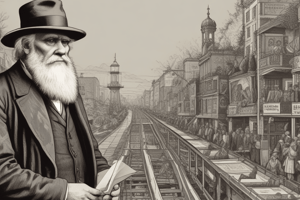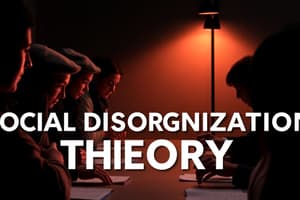Podcast
Questions and Answers
What does Durkheim suggest is the outcome of anomie in society?
What does Durkheim suggest is the outcome of anomie in society?
- Increased social conformity
- Enhanced community solidarity
- Crime (correct)
- Economic growth
How does the mechanical model of society function according to Durkheim?
How does the mechanical model of society function according to Durkheim?
- Through interdependence among specialized roles
- By promoting individual ambitions
- It functions through pressure to conform. (correct)
- Through decentralized authority
What is a key characteristic of organic solidarity as defined by Durkheim?
What is a key characteristic of organic solidarity as defined by Durkheim?
- Interdependence among individuals with diverse roles (correct)
- Complete uniformity in societal roles
- Social roles dictated by the government
- Absence of laws to regulate behavior
Which factor does Durkheim associate with a breakdown of norms and the occurrence of anomie?
Which factor does Durkheim associate with a breakdown of norms and the occurrence of anomie?
What criticism can be made about the assumptions of human ecology theory?
What criticism can be made about the assumptions of human ecology theory?
What is the primary focus of subcultural theories in relation to young males?
What is the primary focus of subcultural theories in relation to young males?
What is one of the functions of gangs within social structure theory?
What is one of the functions of gangs within social structure theory?
How do anomie and strain theories impact criminology?
How do anomie and strain theories impact criminology?
What is one of the focal concerns identified by Miller related to working-class males?
What is one of the focal concerns identified by Miller related to working-class males?
According to Wolfgang and Ferracutti, what is a significant consequence of not engaging in violence within lower socioeconomic communities?
According to Wolfgang and Ferracutti, what is a significant consequence of not engaging in violence within lower socioeconomic communities?
What does the concept of 'fate' in Miller's theory suggest about the working-class perspective on their future?
What does the concept of 'fate' in Miller's theory suggest about the working-class perspective on their future?
What is not considered one of the six focal concerns according to Miller?
What is not considered one of the six focal concerns according to Miller?
What statement best reflects Anderson's view on marginalized individuals in society?
What statement best reflects Anderson's view on marginalized individuals in society?
In Wolfgang and Ferracutti's research, what community is highlighted for a subculture of violence?
In Wolfgang and Ferracutti's research, what community is highlighted for a subculture of violence?
What factor is essential in developing self-control during early childhood?
What factor is essential in developing self-control during early childhood?
What factor influences the delinquent behavior of working-class individuals according to Miller's theory?
What factor influences the delinquent behavior of working-class individuals according to Miller's theory?
Which focal concern relates to the ability to outsmart others through cleverness rather than academic intelligence?
Which focal concern relates to the ability to outsmart others through cleverness rather than academic intelligence?
Which characteristic is NOT associated with individuals who commit crimes due to low self-control?
Which characteristic is NOT associated with individuals who commit crimes due to low self-control?
In self-control theory, what does 'opportunity' refer to?
In self-control theory, what does 'opportunity' refer to?
How can parental criminality impact a child's self-control?
How can parental criminality impact a child's self-control?
What concept relates to labeling a person as a criminal and its effects?
What concept relates to labeling a person as a criminal and its effects?
What perspective do social process criminologists operate from?
What perspective do social process criminologists operate from?
According to differential association theory, where does the learning of criminal behavior primarily occur?
According to differential association theory, where does the learning of criminal behavior primarily occur?
Which of the following is NOT a principle of differential association theory?
Which of the following is NOT a principle of differential association theory?
What does social learning theory offer in relation to differential association theory?
What does social learning theory offer in relation to differential association theory?
What key element distinguishes social control theories from social learning theories according to Sowell's visions?
What key element distinguishes social control theories from social learning theories according to Sowell's visions?
Which theory emphasizes that criminal behavior is learned from others who share values and attitudes?
Which theory emphasizes that criminal behavior is learned from others who share values and attitudes?
How does labeling theory impact policy recommendations?
How does labeling theory impact policy recommendations?
What is a key criticism of differential association theory?
What is a key criticism of differential association theory?
What does the attachment component of Hirschi's Social Bond Theory primarily focus on?
What does the attachment component of Hirschi's Social Bond Theory primarily focus on?
How does the commitment component of Social Bond Theory influence criminal behavior?
How does the commitment component of Social Bond Theory influence criminal behavior?
Which statement best describes the involvement element in the context of Social Bond Theory?
Which statement best describes the involvement element in the context of Social Bond Theory?
What is the central premise of Gottfredson and Hirschi's Low Self-Control Theory?
What is the central premise of Gottfredson and Hirschi's Low Self-Control Theory?
Which characteristic is commonly associated with individuals who have low self-control?
Which characteristic is commonly associated with individuals who have low self-control?
In the context of Hirschi's theory, lacking which element is most likely to lead to disbelief in conventional morality?
In the context of Hirschi's theory, lacking which element is most likely to lead to disbelief in conventional morality?
What role do parental approval and discipline play in the commitment component of Social Bond Theory?
What role do parental approval and discipline play in the commitment component of Social Bond Theory?
How does Hirschi's concept of 'Idle hands are the devil's workshop' relate to involvement?
How does Hirschi's concept of 'Idle hands are the devil's workshop' relate to involvement?
What does primary deviance refer to?
What does primary deviance refer to?
Which technique of neutralization involves the offender claiming no real offense occurred?
Which technique of neutralization involves the offender claiming no real offense occurred?
What is one of the negative elements of Sykes and Matza's Neutralization Theory?
What is one of the negative elements of Sykes and Matza's Neutralization Theory?
Which proposition states that criminal behavior is learned through communication?
Which proposition states that criminal behavior is learned through communication?
What does cognitive dissonance refer to in the context of deviant behavior?
What does cognitive dissonance refer to in the context of deviant behavior?
Which of these is NOT one of the techniques of neutralization?
Which of these is NOT one of the techniques of neutralization?
What is described as a positive aspect of Sykes and Matza's Neutralization Theory?
What is described as a positive aspect of Sykes and Matza's Neutralization Theory?
What is a key assertion of Differential Association Theory?
What is a key assertion of Differential Association Theory?
Which of the following describes 'Denial of Victim' technique?
Which of the following describes 'Denial of Victim' technique?
In the context of learning criminal behavior, what is essential according to the nine propositions?
In the context of learning criminal behavior, what is essential according to the nine propositions?
Flashcards
Anomie
Anomie
A state of moral confusion or breakdown in society, or a gap between societal goals and the means to achieve them.
Mechanical Solidarity
Mechanical Solidarity
Social cohesion based on similarity and shared values, leading to high levels of conformity.
Organic Solidarity
Organic Solidarity
Social cohesion based on interdependence and specialization of roles, leading to more complex societies.
Chicago School
Chicago School
Signup and view all the flashcards
Durkheim's Anomie Theory
Durkheim's Anomie Theory
Signup and view all the flashcards
Social Structural Tradition
Social Structural Tradition
Signup and view all the flashcards
Subcultural Theories
Subcultural Theories
Signup and view all the flashcards
Anomie/Strain Tradition Impact
Anomie/Strain Tradition Impact
Signup and view all the flashcards
Miller's Focal Concerns
Miller's Focal Concerns
Signup and view all the flashcards
Focal Concern: Excitement
Focal Concern: Excitement
Signup and view all the flashcards
Focal Concern: Toughness
Focal Concern: Toughness
Signup and view all the flashcards
Subculture of Violence
Subculture of Violence
Signup and view all the flashcards
Anderson's Code of the Street
Anderson's Code of the Street
Signup and view all the flashcards
Strain Theory (Anderson)
Strain Theory (Anderson)
Signup and view all the flashcards
Wolfgang and Ferracuti's Theory
Wolfgang and Ferracuti's Theory
Signup and view all the flashcards
Focal Concern: Smartness
Focal Concern: Smartness
Signup and view all the flashcards
Social Process Theories
Social Process Theories
Signup and view all the flashcards
Symbolic Interactionism
Symbolic Interactionism
Signup and view all the flashcards
Differential Association Theory
Differential Association Theory
Signup and view all the flashcards
Learning Criminal Behavior
Learning Criminal Behavior
Signup and view all the flashcards
Social Learning Theory
Social Learning Theory
Signup and view all the flashcards
Social Control Theories
Social Control Theories
Signup and view all the flashcards
Labeling Theory
Labeling Theory
Signup and view all the flashcards
Neutralization Theory
Neutralization Theory
Signup and view all the flashcards
Attachment (Social Bond Theory)
Attachment (Social Bond Theory)
Signup and view all the flashcards
Commitment (Social Bond Theory)
Commitment (Social Bond Theory)
Signup and view all the flashcards
Involvement (Social Bond Theory)
Involvement (Social Bond Theory)
Signup and view all the flashcards
Belief (Social Bond Theory)
Belief (Social Bond Theory)
Signup and view all the flashcards
Low Self-Control
Low Self-Control
Signup and view all the flashcards
Self-Control Theory
Self-Control Theory
Signup and view all the flashcards
Prosocial Attachment
Prosocial Attachment
Signup and view all the flashcards
Idle Hands
Idle Hands
Signup and view all the flashcards
Low Self-Control Theory
Low Self-Control Theory
Signup and view all the flashcards
Opportunity (in self-control theory)
Opportunity (in self-control theory)
Signup and view all the flashcards
Self-Fulfilling Prophecy (in Crime)
Self-Fulfilling Prophecy (in Crime)
Signup and view all the flashcards
Parental influences on self-control
Parental influences on self-control
Signup and view all the flashcards
Tannenbaum's Labeling Theory
Tannenbaum's Labeling Theory
Signup and view all the flashcards
Primary Deviance
Primary Deviance
Signup and view all the flashcards
Secondary Deviance
Secondary Deviance
Signup and view all the flashcards
Neutralization Theory
Neutralization Theory
Signup and view all the flashcards
Denial of Responsibility
Denial of Responsibility
Signup and view all the flashcards
Denial of Injury
Denial of Injury
Signup and view all the flashcards
Denial of Victim
Denial of Victim
Signup and view all the flashcards
Condemnation of the Condemners
Condemnation of the Condemners
Signup and view all the flashcards
Appeal to Higher Loyalties
Appeal to Higher Loyalties
Signup and view all the flashcards
Differential Association
Differential Association
Signup and view all the flashcards
Criminal Behavior is Learned
Criminal Behavior is Learned
Signup and view all the flashcards
Study Notes
Learning Objectives
- State the basic premise of the social structural tradition.
- Explain the assumptions of human ecology theory, its major findings, and criticisms.
- Describe the evolution of the anomie tradition and how the various versions differ.
- Discuss the basic ideas of subcultural theories, how they form, and how status concerns of young males are met in those subcultures.
- Evaluate why gangs are formed, their function, and their relationship to social structure.
- Evaluate the impact of anomie/strain tradition on criminology.
- Debate the policy and prevention implications of social structure theories.
Social Structure Theories
The Chicago School
- Durkheim
- Anomie: a moral confusion or gap between goals and means in society.
- Mechanical solidarity: societies function like a machine, enforcing conformity through a legal system. There's no division of labor, and crime is normal.
- Organic solidarity: societies interact with different parts working together. Crime occurs when this system is disrupted, such as during war or economic depression.
- Outcome of Anomie is often crime. Modern societies have personal ambitions; when diverse goals cause a gap between expectations and reality, anomie develops.
- Chicago School: a sociological school in the 1920s and 1930s focusing on urban ecological and ethnographic studies of Chicago.
- Park and Burgess Concentric Zone Theory: The city is segmented into zones with different social characteristics. Zone 2 (transition zone) is characterized by high crime rates due to social disorganization. Zone 1 is the business district, Zone 2 is transitional (poor), and zones 3, 4, and 5 have increasing wealth and social stability.
- Shaw and McKay's Social Disorganization Theory: high crime rates occur in socially disorganized areas due to a lack of social cohesion and social capital.
Strain Theories
- Merton's Strain Theory (1938): Differences between Durkheim and Merton's view of anomie; Durkheim emphasizes rapid social change, while Merton sees anomie as a constant, stratified element.
- Anomie arises from a gap between cultural goals and the socially structured means to attain them, especially in societies that emphasize the "American Dream."
- Merton's modes of adaptation:
- Conformist: Accepts goals and means
- Innovator: Accepts goals but rejects means (e.g., crime)
- Ritualist: Rejects goals but conforms to means
- Retreatist: Rejects both goals and means (e.g., drug use)
- Rebel: Rejects goals and means, seeking to replace them with new goals and means
- Messner and Rosenfeld's Institutional Anomie (1994): Economic institutions dominating other societal institutions weakening external controls; imbalances in the system creating anomie.
Subcultural Theories
- Cohen's (1995): Middle class measuring rod; lower class youth, unable to achieve middle-class goals, develop a subculture that rejects middle-class values in favor of their own norms.
- Cloward and Ohlin's Differential Opportunity Theory: Criminality is a result of limited access to both legitimate and illegitimate opportunities, which leads to the formation of different subcultures: criminal, conflict, and retreatist.
- Miller's Focal Concern Theory: Working-class values and norms differ significantly from middle-class values and norms, and this different approach to society can be problematic because the standards are different.
Social Learning Theory, Control and Labeling Theories
- Social Learning Theory: Criminal behavior is learned through observation and imitation of others, differential reinforcement, and differential association.
- Control Theories: Emphasize factors that prevent individuals from committing crime (e.g., attachment to others, commitment to social norms, involvement in conventional activities, belief in societal values).
- Hirschi's Social Bond Theory: People who have strong bonds (attachment, commitment, involvement, and belief) to society are less likely to commit crimes.
- Social Control Theories: Emphasize the importance of social bonds (e.g., attachment to family/peers, attachment to school or other institutions, beliefs and conformity) in preventing crimes. If social bonds are weak, deviance is more likely.
- Labeling Theories: Individuals labeled as criminal by society are more likely to engage in further criminal behavior.
- Neutralization Theory: Individuals neutralize moral constraints prior to committing crime through rationalization and justification. This is a way of justifying behaviors that are usually seen as unacceptable.
Studying That Suits You
Use AI to generate personalized quizzes and flashcards to suit your learning preferences.





